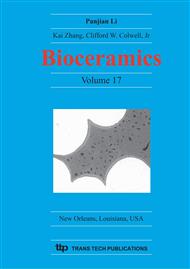p.517
p.521
p.525
p.531
p.537
p.541
p.545
p.549
p.553
Glutamate Release by Osteoblasts in the Presence of Ionic Products from Bioactive Glass 60S
Abstract:
Osteoblasts constitutively release glutamate and this release appears to be regulated by calcium entry. In this work we investigated if the bioactive glass with 60% of silicon (BG60S) could alter glutamate release by osteoblasts. We demonstrated that osteoblasts incubated with medium containing ionic products from the dissolution of BG60S showed lower release of glutamate when compared to control. Since intracellular calcium (Cai 2+) increase is required for glutamate release we investigated the subcellular distribution of the calcium channel inositol triphosphate receptors (InsP3Rs) in the presence of BG60S compared to control. We found that the type-III InsP3R was not expressed in osteoblast, while the type-II InsP3R was expressed mainly in the cytosol. We also found that the expression of type-II InsP3R decreased in BG60S treated osteoblasts compared to control. On the other hand, we found that the type-I InsP3R was expressed mainly in the nucleus and its expression increased in the presence of the biomaterial.
Info:
Periodical:
Pages:
537-540
Citation:
Online since:
April 2005
Keywords:
Price:
Сopyright:
© 2005 Trans Tech Publications Ltd. All Rights Reserved
Share:
Citation:


